You have a great product.
But how can you present it in a way that makes people want to buy it?
That’s where sales psychology comes in. You need to get into the buyer’s mind if you want to create a pitch that genuinely resonates with them.
Fortunately, sales psychology is a well-researched field, so there’s no need to reinvent the wheel.
You can simply learn what works, then apply it to selling your product.
Let’s get straight into it…
We Buy Based on Emotions, Then Use Reason to Justify the Purchase
Gerald Zaltman, professor emeritus at the Harvard Business School and the author of “How Customers Think: Essential Insights into the Mind of the Market,” argues that purchase decision-making happens primarily in the subconscious mind.
He explains that several research methods can help understand this process:
- Comparing stated beliefs with actual behavior – For example, people often say that they compare multiple options before buying a product, but they don’t even look at the alternatives to their chosen brand.
- Measuring physiological responses – There are physiological reactions that people can’t control that show what they think. These physiological responses often contradict what they say.
- Studying metaphors that consumers use – The metaphors that people use to express their thoughts and feelings can provide insight into their true motivations, desires, and fears.
All this has led Zaltman to conclude that an astonishing 95% of our purchase decision-making takes place in our subconscious mind.
So how can you tap into what drives purchasing decisions?
Meet Maslow’s Hierarchy of Needs
Abraham Maslow was a psychologist who is best known for his hierarchy of needs theory.
He argued that:
- There are universal human needs
- These universal human needs exist in a hierarchy
- The lower-level needs must be met for the person to feel motivated to fulfill the higher-level needs
Here’s how his hierarchy of needs looks like:
- Basic – Air, food, water, clothes, shelter, sleep, etc
- Safety – Personal security, emotional security, financial security, etc
- Social belonging – Friendships, romance, family, etc
- Self-Esteem – Respect for oneself, respect from others
- Self-actualization – Realizing one’s full potential
- Transcendence – Giving oneself to something beyond oneself
This hierarchy of needs is often illustrated with a Maslow’s pyramid:
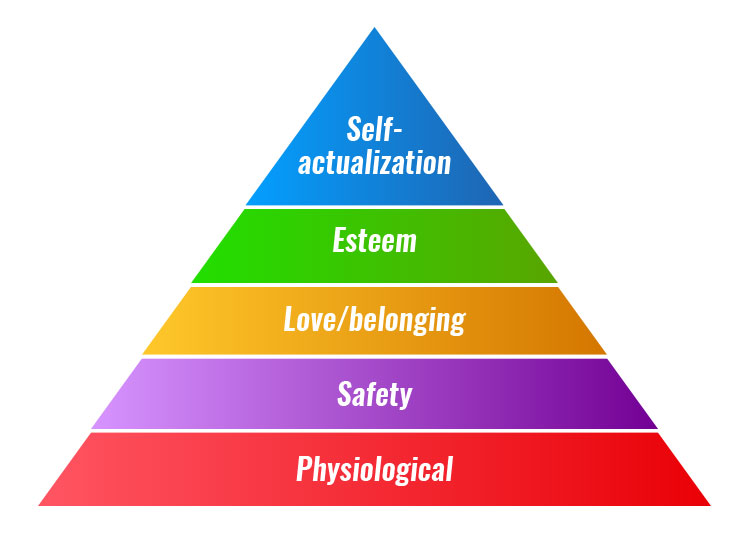
Imagine that someone is holding your head underwater.
Your mind would be focused entirely on one thing: getting oxygen.
You wouldn’t be able to think about anything else until the need for oxygen was met.
That’s the main idea behind Maslow’s hierarchy of needs:
A lower-level need will dominate the mind and prevent it from focusing on higher-level needs until it is met.
Of course, there are exceptions to this, say, starving artists.
That being said, the theory generally holds true.
That’s why it can help us better understand ourselves and others.
Note: Maslow’s pyramid depicts self-actualization at the top, which is congruent with his initial theory, but it’s essential to know that in his later years, Maslow criticized his original vision and argued that transcendence is a the top of the hierarchy of needs.
How to Apply Maslow’s Hierarchy of Needs to Sales
So how can you apply Maslow’s hierarchy of needs to sales?
- Determine which one of the universal human needs is dominant in the mind of your potential customer.
- Focus on that need when you are selling your product.
- Paint a vivid picture of a better life.
Now, you can’t just dream all this up; you need to conduct customer research.
Figure out where your potential customers hang out, then go there and observe their discussions.
This could mean:
- Going through relevant subreddits
- Joining niche online forums
- Following Twitter conversations
- Reading YouTube comments
- Reading Amazon reviews
Etc.
Of course, you should also try to talk to your potential customer one-on-one, so don’t hesitate to reach out to people in your target audience for customer interviews.
All of this will help you understand their hopes, fears, and dreams.
You should also pay attention to the exact words, phrases, and metaphors they use to express themselves.
That will allow you to speak to them in their own language and invoke imagery that is already present in their minds.
Example: ConvertKit
ConvertKit sells email marketing software to online creators.
It’s probably safe to say the need for self-actualization predominantly drives the average person in their target audience.
And that’s what the company emphasizes on their homepage:
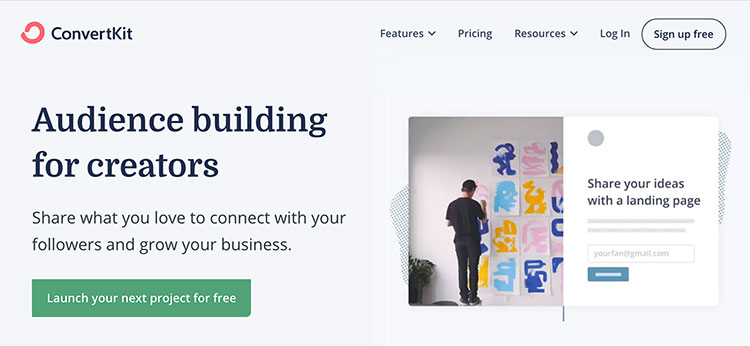
As you can see, they don’t go for the “make money online” angle despite being an email marketing company.
Instead, they talk to “creators” about “building an audience” and “sharing what you love.” Why?
Because they understand that it’s not about the money; it’s about the self-realization.
The 6 Principles of Persuasion That You Must Adhere to
Robert Cialdini is a professor of psychology and marketing at Arizona State University.
He is best known for his groundbreaking 1984 book “Influence: The Psychology of Persuasion” which has since sold over three million copies.
Cialdini spent three years “undercover” in used car dealerships, telemarketing companies, and charity organizations. Why?
He wanted to observe how influence works in real life.
That’s how he discovered the six fundamental principles of influence.
Let’s take a closer look at each of them…
Principle #1: Reciprocity
We feel obliged to return favors.
This often unconscious sense of obligation is surprisingly strong.
This principle can be applied in a business context by intentionally creating that sense of obligation in the potential customer’s mind.
This is usually done by offering them a small gift, making them more likely to buy something from you as a show of reciprocity.
That gift can be a free download, a free sample, an inexpensive product, etc.
Principle #2: Commitment and Consistency
We value consistency in others, and we want to be seen as consistent ourselves.
Obviously, there’s a social aspect to this behavior because publicly changing your mind on something often comes with a social cost.
But this desire to remain consistent is so strong that it tends to override reason even in situations where you would not incur any significant social cost.
This principle is often applied through the “Foot in the Door” technique in a business context.
You get the potential customer to commit to something, then use that small initial commitment to escalate to more extensive commitments.
This why having a range of products is better than having just one.
For example, the New York Times best-selling author and famous blogger Ramit Sethi offers a wide variety of products.
They range from his book “I Will Teach You To Be Rich” which costs less than $10 to courses like Finisher’s Formula, which costs a few hundred dollars, to flagship courses like Find Your Dream Job, which cost thousands of dollars.

It’s much easier to get someone to spend ten bucks on a book than to persuade them to drop several grand on an online course.
But once they buy that book, they become more likely to buy the next product, then the next one, and so on.
All because you got your foot in the door with a $10 book.
Principle #3: Social Proof
When we are unsure of what to do, we look at what others do.
In a business context, this means that your potential customers will seek reassurance from others.
You can provide that reassurance by:
#1: Featuring Customer Testimonials
It’s crucial that the testimonial is not only real but also looks realistic.
It helps to include:
- Photo
- Company name
- Job title
- Website
- Twitter handle
Of course, it’s ideal if the potential customer already knows and respects the person who provided the testimonials.
For Example:
Agency Analytics is a reporting platform for digital agencies.
They have a Customer Success Stories section on their homepage, which features three testimonials:
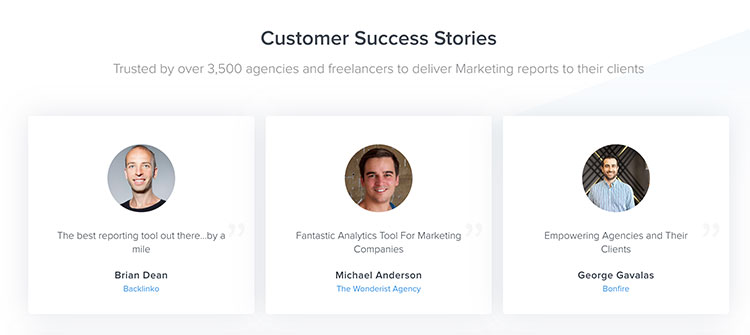
It’s probably safe to say that anyone who runs a digital marketing agency will immediately recognize Brian Dean.
He’s the founder of Backlinko, one of the top SEO blogs out there, and a world-renowned SEO expert.
You may not know anything about AgencyAnalytics, but if you are a Backlinko reader, you will be inclined to trust them because Brian Dean vouched for them.
The testimonials from the Wonderist Agency co-founder Michael Anderson and the Bonfire Group’s head of digital services, George Gavalas, add even more credibility to the company.
#2: Featuring Customer Case Studies
Everyone knows that you are biased when it comes to your product.
That’s why potential customers will always take what you say about your product with a grain of salt.
What they want to know is this:
Does your product deliver on its promise?
You can answer that question by providing customer case studies.
For example, when the previously mentioned Brian Dean reopened his flagship course, “SEO That Works 4.0”, he didn’t just tell his email subscribers how great the course was.
He also provided social proof, including three new case studies of his former students:


Did your existing customers get the results they wanted?
Then reach out to them, interview them, and write up case studies.
Let their results speak for themselves.
#3: Featuring “As Seen On” Badges
Has your product been featured in the media?
If so, then you should put “As Seen On” badges on your homepage.
For Example:
Quip sells oral hygiene products.
Its innovative electric toothbrush has received a lot of acclaims.
It has been named Best Electric Toothbrush by the GQ magazine and featured in the “25 best inventions” list by the TIME magazine.
Quip features TIME and GQ badges on their homepage:

What do you think when you see this?
“This toothbrush must be legit.”
So go out there, get those media mentions, then display the badges on your website. It will immediately make you look more credible.
Principle #4: Liking
We are more likely to accept offers from those we like than from those we dislike. But what makes us like other people?
Physical Attractiveness
We like attractive people.
There’s something called the Halo effect.
We tend to notice one positive trait of a person, then project other positive qualities onto them, as if that one positive trait casts a halo that makes us see that person in a positive light.
Its most well-known example is the tendency to unconsciously assume that an attractive person must also be intelligent, honest, kind, etc.
What does this mean in a business context?
- You can become more persuasive by merely becoming more attractive (getting in shape, proper grooming, stylish clothes, etc.).
- It’s better to have attractive people in customer-facing roles, including roles like a product evangelist.
- It makes sense to use images of attractive people to promote your product because their attractiveness will cast a “halo” on whatever it is that you are selling.
For example, Carl’s Jr. is known for their burgers and their risque Super Bowl commercials featuring attractive women eating those burgers.

That being said, you don’t want the attractive person to be too dissimilar to your potential customers because then their attractiveness might have the opposite effect.
For Example:
If you are selling a product to stay-at-home moms in their 30s, then putting an image of a 22-year-old fashion model on your ads is probably not the best idea. Why?
The model looks nothing like your potential customers, so the ad will not resonate with them.
However, you could use an image of an attractive 35-year-old woman dressed in regular clothes instead, which would allow you to benefit from the Halo effect.
When it comes to using physical attractiveness in marketing, you want to go for a “just like you, but more attractive” look, aspirational, not the “supermodel” look, which is unrelatable.
Being Similar to Us in Some Way
We like people who are similar to us in some way.
This includes similar:
- Religious beliefs
- Political beliefs
- Careers
- Hobbies
- Interests
Etc.
So think about what you have in common with your potential customers and emphasize that.
This is easy for the “scratch your own itch” products where the founder is also a customer.
But you can probably find something in common with your potential customers, even if they seem to be nothing like you at first glance.
At the very least, you should adopt their style of communication, including tone, jargon, memes, etc.
Paying Us Compliments
We like people that give us compliments.
When you are making your sales pitch, try to compliment the potential customer.
This doesn’t necessarily have to be a direct “You look pretty today” type of compliment.
Just find a way to make the potential customer feel good about themselves.
Working Together Towards a Common Goal
We tend to trust people with whom we have worked together towards a common goal.
You can also think about it this way: experiencing hardship together makes us feel a bond with each other.
This can mean anything from being college roommates to going through a medical residency to fighting in a war.
In a business context, this principle can be applied by publicly setting a goal, then sharing your progress with your potential customers so that they’d become invested in your success.
For example, Groove, a company that sells helpdesk software, used content marketing to build a $5M/year business in just three years.
Their blog used to be called “A SaaS Startup’s Journey to $100,000 in Monthly Revenue”.
The premise was simple: they shared everything they learned while building a software company.
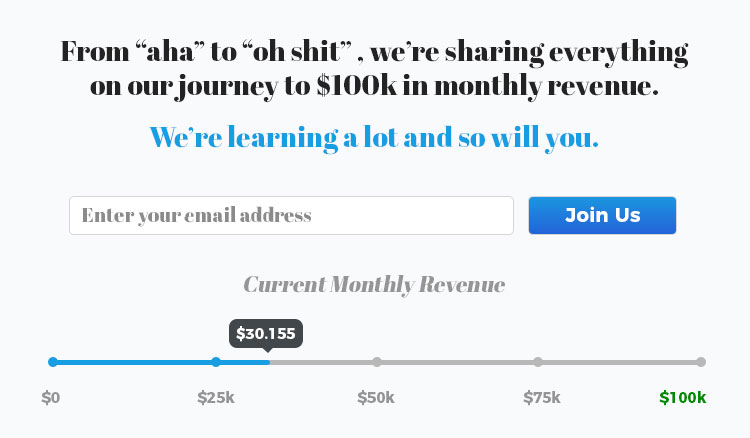
This approach, known as “building in public,” can endear you to your potential customers when done right, which then makes them more likely to buy your product eventually.
Making Us Laugh
We like people who make us laugh.
A lighthearted tone often works well when building a relationship with a potential customer.
For Example:
Dynamite Jobs is a job board where location independent businesses can advertise remote jobs.
The team sends out a weekly newsletter called “Remotely Interesting.”
It features “Remote jobs and some news with a joke or two from Dino the Dynamite Alpaca.”
The jokes are cheesy, but they are amusing, for example:
“A work week is so rough that after Monday and Tuesday, even the calendar says WTF.”
These newsletters are signed by “Dino the Dynamite Alpaca and the Dynamite Jobs Team.”
In case you are puzzled by the whole alpaca thing, Dino the Dynamite Alpaca is the Dynamite Jobs mascot.

All this helps Dynamite Jobs create a casual, friendly, down-to-Earth brand image that appeals to their target audience of digital nomads.
Of course, this won’t work for all businesses. It can prove disastrous in some industries. Nobody appreciates a funeral home employee cracking jokes.
That being said, if you think that a more lighthearted tone might resonate with your target audience, don’t be afraid to experiment with it.
Just remember that while you shouldn’t be too formal, you don’t want to come off as crass and inappropriate either.
It’s important to get the tone just right.
Principle #5: Authority
We tend to obey authority.
The degree to which we are willing to do so is disturbing, as demonstrated by the famous Milgram experiments.
This means that people will be more likely to buy from you if they see you as an authority in a business context.
It makes sense to establish yourself as an expert in the field, display relevant credentials, and share previous accomplishments.
Principle #6: Scarcity
We value scarce things.
The less available something is, the more we want it.
This is why people play hard to get when dating, go crazy on Black Friday and pay through the nose for vintage wines.
This principle can be implemented with limited-time deals in a business context, but you need to do it right if you don’t want to alienate your customers.
For Example:
The previously mentioned Ramit Sethi has an online course called “Find Your Dream Job.”

As you can see, you can’t just enroll in this course whenever you feel like it. You need to get on the waiting list.
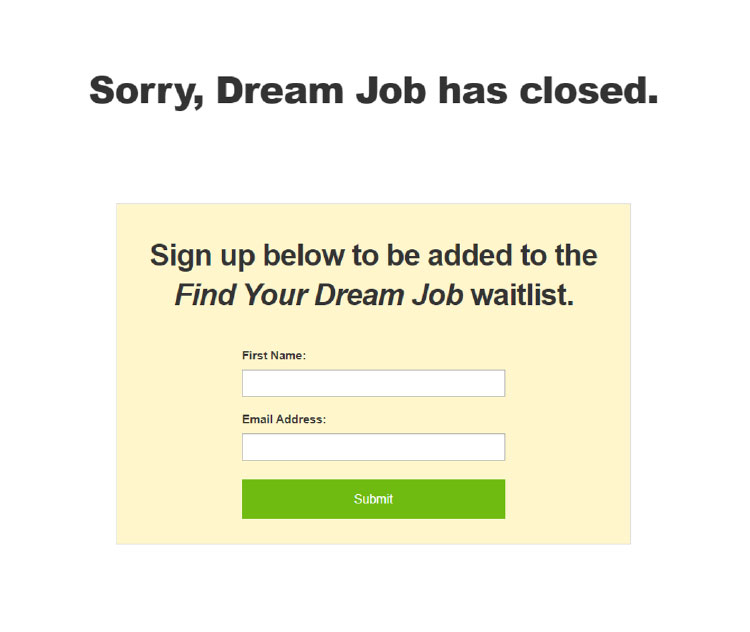
Now, this isn’t just a sales gimmick; Ramit Sethi has a reason for this.
He needs to control enrollment to provide his students with adequate support.
And that’s the best way to implement the principle of scarcity.
You should only use it when you are dealing with resource constraints. In other words, when there’s an actual scarcity.
Other examples could be personal coaching, live events, etc.
Use Sales Psychology Responsibly!
Everything that we have discussed in this article can be used to manipulate people.
That’s why it’s so important to make sure that you have an excellent product that genuinely makes people’s lives better.
When that’s the case, you have to be as effective as you can at selling it because otherwise, you’d be depriving the potential customer of its benefits.
So before you start selling, ask yourself, do you truly believe in your product?
Never compromise your ethics to make a quick buck.
Use sales psychology responsibly.
Conclusion
We humans are not rational creatures. Our emotions govern us.
This applies to everyone. It’s tempting to believe that you are an exception, but that would be just deluding yourself.
We all make decisions based on emotion, then use reason to justify them to ourselves and others.
Want to get better at sales? Then learn to work with human nature and not against it. Study psychology.





